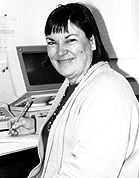| T H E N I H C A T A L Y S T | S E P T E M B E R - O C T O B E R 1 9 9 6 | ||||
|
ETHICS FORUM: INTRAMURAL SEEING by Joan P. Schwartz, Ph.D. , NINDS In the January-February issue of The NIH Catalyst, you may recall a box, entitled "Ethics in Peer Review: A Scenario to Consider." We invited readers to give their perspective on the following situation: A Dr. White reviewed the paper of a Dr. Red, despite the fact that White's lab was working on the same research problem. White shared the paper with colleagues in his lab, delayed publication by asking for revisions, and subsequently submitted a paper with results essentially identical to Red's, without citing Red's paper. We received two thoughtful responses: one from Suzanne Epstein at CBER and one from William H. Goldwater, who retired in 1993 from the Office of Extramural Research. Epstein writes: In my opinion, Dr. White had a clear conflict of interest and should not have reviewed the manuscript, since he was working on something too closely related. It is necessary to be competent in
Dr. White should have returned the paper without reading beyond the title. The journal could also have done better and prevented the problem. Dr. White should not have had the opportunity to read the manuscript. A journal I review for calls ahead with the title of a paper (and additional information if needed for a decision) to ask whether I can review it, and if there is a clear conflict of interest, the paper is not sent in the first place. Goldwater writes: During the last years of my tenure in OER/OD, I developed and implemented many rules and regulations governing conflicts of interest and related topics for extramural operations (and pertinent likewise to intramural). This example shows many flaws in White's behavior, mostly in failing to communicate adequately with various other folks -- contrary to NIH scientific peer-review standards for grants and contracts. These failures include
Having committed these various breaches in the process, White should now, belatedly, communicate with Red and Journal L, where he published, regarding his failures of judgment. He should seek forgiveness and try to make amends. He certainly should have communicated earlier. This situation is similar to one presented last summer in the AAAS online forum involving a half dozen or so scenarios concerning ethical problems in research. During my communications with that AAAS forum last summer, I found that many persons and agencies do not hold to the same high standards as does NIH in avoiding conflicts of interest in peer reviews of grant/contract proposals. Some groups even allow a reviewer simply to inform the staff person running the review that he/she has a conflict, and then proceed to review the proposal as if nothing were wrong. What actually happened: In fact, the scenario was based on the experience of an intramural scientist who suffered Red's fate. Conversations with "Dr. White" failed to elicit any satisfactory response and "Dr. Red" has now filed a complaint with the Office of Research Integrity.
|
|||||
